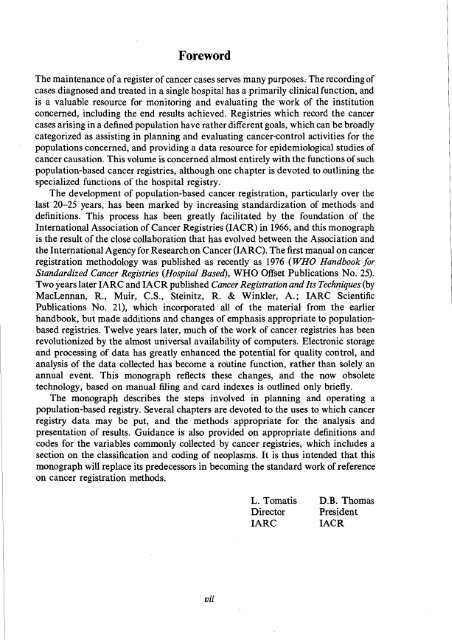Cancer Registration: Principles and Methods - IARC
Cancer Registration: Principles and Methods - IARC
Cancer Registration: Principles and Methods - IARC
You also want an ePaper? Increase the reach of your titles
YUMPU automatically turns print PDFs into web optimized ePapers that Google loves.
Foreword<br />
The maintenance of a register of cancer cases serves many purposes; The recording of<br />
cases diagnosed <strong>and</strong> treated in a single hospital has a primarily clinical function, <strong>and</strong><br />
is a valuable resource for monitoring <strong>and</strong> evaluating the work of the institution<br />
concerned, including the end results achieved. Registries which record the cancer<br />
cases arising in a defined population have rather different goals, which can be broadly<br />
categorized as assisting in planning <strong>and</strong> evaluating cancer-control activities for the<br />
populations concerned, <strong>and</strong> providing a data resource for epidemiological studies of<br />
cancer causation. This volume is concerned almost entirely with the functions of such<br />
population-based cancer registries, although one chapter is devoted to outlining the<br />
specialized functions of the hospital registry.<br />
The development of population-based cancer registration, particularly over the<br />
last 20-25 years, has been marked by increasing st<strong>and</strong>ardization of methods <strong>and</strong><br />
definitions. This process has been greatly facilitated by the foundation of the<br />
International Association of <strong>Cancer</strong> Registries (IACR) in 1966, <strong>and</strong> this monograph<br />
is the result of the close collaboration that has evolved between the Association <strong>and</strong><br />
the International Agency for Research on <strong>Cancer</strong> (<strong>IARC</strong>). The first manual on cancer<br />
registration methodology was published as recently as 1976 (WHO H<strong>and</strong>book for<br />
St<strong>and</strong>ardized <strong>Cancer</strong> Registries (Hospital Based), WHO Offset Publications No. 25).<br />
Two years later <strong>IARC</strong> <strong>and</strong> IACR published <strong>Cancer</strong> <strong>Registration</strong> <strong>and</strong> Its Techniques (by<br />
MacLennan, R., Muir, C.S., Steinitz, R. & Winkler, A.; <strong>IARC</strong> Scientific<br />
Publications No. 21), which incorporated all of the material from the earlier<br />
h<strong>and</strong>book, but made additions <strong>and</strong> changes of emphasis appropriate to populationbased<br />
registries. Twelve years later, much of the work of cancer registries has been<br />
revolutionized by the almost universal availability of computers. Electronic storage<br />
<strong>and</strong> processing of data has greatly enhanced the potential for quality control, <strong>and</strong><br />
analysis of the data collected has become a routine function, rather than solely an<br />
annual event. This monograph reflects these changes, <strong>and</strong> the now obsolete<br />
technology, based on manual filing <strong>and</strong> card indexes is outlined only briefly.<br />
The monograph describes the steps involved in planning <strong>and</strong> operating a<br />
population-based registry. Several chapters are devoted to the uses to which cancer<br />
registry data may be put, <strong>and</strong> the methods appropriate for the analysis <strong>and</strong><br />
presentation of results. Guidance is also provided on appropriate definitions <strong>and</strong><br />
codes for the variables commonly collected by cancer registries, which includes a<br />
section on the classification <strong>and</strong> coding of neoplasms. It is thus intended that this<br />
monograph will replace its predecessors in becoming the st<strong>and</strong>ard work of reference<br />
on cancer registration methods.<br />
L. Tomatis D.B. Thomas<br />
Director President<br />
<strong>IARC</strong> IACR<br />
vii
















